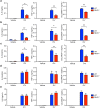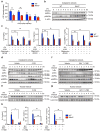Mint3/Apba3 depletion ameliorates severe murine influenza pneumonia and macrophage cytokine production in response to the influenza virus
- PMID: 27883071
- PMCID: PMC5121658
- DOI: 10.1038/srep37815
Mint3/Apba3 depletion ameliorates severe murine influenza pneumonia and macrophage cytokine production in response to the influenza virus
Abstract
Influenza virus (IFV) infection is a common cause of severe pneumonia. Studies have suggested that excessive activation of the host immune system including macrophages is responsible for the severe pathologies mediated by IFV infection. Here, we focused on the X11 protein family member Mint3/Apba3, known to promote ATP production via glycolysis by activating hypoxia inducible factor-1 (HIF-1) in macrophages, and examined its roles in lung pathogenesis and anti-viral defence upon IFV infection. Mint3-deficient mice exhibited improved influenza pneumonia with reduced inflammatory cytokines/chemokine levels and neutrophil infiltration in the IFV-infected lungs without alteration in viral burden, type-I interferon production, or acquired immunity. In macrophages, Mint3 depletion attenuated NF-κB signalling and the resultant cytokine/chemokine production in response to IFV infection by increasing IκBα and activating the cellular energy sensor AMPK, respectively. Thus, Mint3 might represent one of the likely therapeutic targets for the treatment of severe influenza pneumonia without affecting host anti-viral defence through suppressing macrophage cytokine/chemokine production.
Figures






Similar articles
-
Loss of CARD9-mediated innate activation attenuates severe influenza pneumonia without compromising host viral immunity.Sci Rep. 2015 Dec 2;5:17577. doi: 10.1038/srep17577. Sci Rep. 2015. PMID: 26627732 Free PMC article.
-
Mint3 enhances the activity of hypoxia-inducible factor-1 (HIF-1) in macrophages by suppressing the activity of factor inhibiting HIF-1.J Biol Chem. 2009 Oct 30;284(44):30350-9. doi: 10.1074/jbc.M109.019216. Epub 2009 Sep 2. J Biol Chem. 2009. PMID: 19726677 Free PMC article.
-
Deletion of the Mint3/Apba3 gene in mice abrogates macrophage functions and increases resistance to lipopolysaccharide-induced septic shock.J Biol Chem. 2011 Sep 16;286(37):32542-51. doi: 10.1074/jbc.M111.271726. Epub 2011 Jul 21. J Biol Chem. 2011. PMID: 21778228 Free PMC article.
-
Curcumin ameliorates severe influenza pneumonia via attenuating lung injury and regulating macrophage cytokines production.Clin Exp Pharmacol Physiol. 2018 Jan;45(1):84-93. doi: 10.1111/1440-1681.12848. Epub 2017 Oct 3. Clin Exp Pharmacol Physiol. 2018. PMID: 28853207
-
Polygalasaponin F treats mice with pneumonia induced by influenza virus.Inflammopharmacology. 2020 Feb;28(1):299-310. doi: 10.1007/s10787-019-00633-1. Epub 2019 Aug 24. Inflammopharmacology. 2020. PMID: 31446589 Free PMC article.
Cited by
-
Integrated functions of membrane-type 1 matrix metalloproteinase in regulating cancer malignancy: Beyond a proteinase.Cancer Sci. 2017 Jun;108(6):1095-1100. doi: 10.1111/cas.13231. Epub 2017 May 22. Cancer Sci. 2017. PMID: 28267240 Free PMC article. Review.
-
Gene expression profiling reveals insights into infant immunological and febrile responses to group B meningococcal vaccine.Mol Syst Biol. 2020 Nov;16(11):e9888. doi: 10.15252/msb.20209888. Mol Syst Biol. 2020. PMID: 33210468 Free PMC article. Clinical Trial.
-
C1q/TNF-related protein 9 inhibits the cholesterol-induced Vascular smooth muscle cell phenotype switch and cell dysfunction by activating AMP-dependent kinase.J Cell Mol Med. 2017 Nov;21(11):2823-2836. doi: 10.1111/jcmm.13196. Epub 2017 May 19. J Cell Mol Med. 2017. PMID: 28524645 Free PMC article.
-
Multifaceted Role of AMPK in Viral Infections.Cells. 2021 May 6;10(5):1118. doi: 10.3390/cells10051118. Cells. 2021. PMID: 34066434 Free PMC article. Review.
-
The Role of Gut Bacteriome in Asthma, Chronic Obstructive Pulmonary Disease and Obstructive Sleep Apnoea.Microorganisms. 2022 Dec 13;10(12):2457. doi: 10.3390/microorganisms10122457. Microorganisms. 2022. PMID: 36557710 Free PMC article. Review.
References
-
- Beigel J. H. et al.. Avian influenza A (H5N1) infection in humans. N. Engl. J. Med. 353, 1374–1385 (2005). - PubMed
-
- Russell C. J. & Webster R. G. The genesis of a pandemic influenza virus. Cell 123, 368–371 (2005). - PubMed
-
- Tumpey T. M. et al.. Characterization of the reconstructed 1918 Spanish influenza pandemic virus. Science 310, 77–80 (2005). - PubMed
-
- Kobasa D. et al.. Aberrant innate immune response in lethal infection of macaques with the 1918 influenza virus. Nature 445, 319–323 (2007). - PubMed
Publication types
MeSH terms
Substances
LinkOut - more resources
Full Text Sources
Other Literature Sources
Medical

